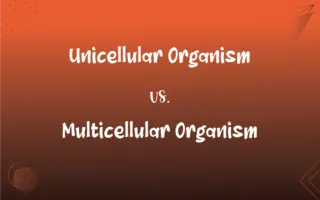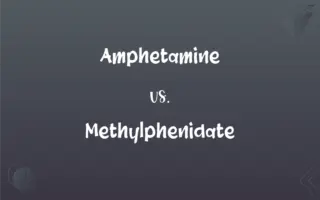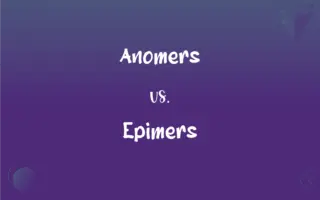Monophyletic vs. Polyphyletic: What's the Difference?
Edited by Aimie Carlson || By Janet White || Published on February 29, 2024
Monophyletic refers to a group of organisms descended from a common ancestor, while polyphyletic groups are formed from multiple ancestral sources.

Key Differences
A monophyletic group, in evolutionary biology, includes an ancestral species and all its descendants, representing a single branch on the tree of life. Polyphyletic groups, however, are composed of organisms from different evolutionary paths, lacking a single common ancestor.
In a monophyletic group, the common ancestor and all its lineage are considered, making it a complete representation of that evolutionary path. Polyphyletic groups are characterized by organisms that have similar traits but these traits evolved independently, not from a common ancestor.
Monophyletic groups are fundamental in understanding evolutionary relationships as they trace back to a single ancestral species. Polyphyletic groupings, while useful in some ecological or functional studies, can be misleading in understanding evolutionary origins.
The classification of organisms into monophyletic groups helps in studying evolutionary processes and patterns. In contrast, polyphyletic groups often arise due to convergent evolution, where unrelated species independently develop similar characteristics.
Examples of monophyletic groups include all mammals descended from a common mammalian ancestor. Polyphyletic groups might include flying animals like birds, bats, and insects, which do not share a common flying ancestor but have developed the ability to fly independently.
ADVERTISEMENT
Comparison Chart
Ancestral Origin
Single common ancestor
Multiple ancestral sources
Evolutionary Path
Represents a single evolutionary branch
Comprises organisms from different evolutionary paths
Importance in Evolution
Traces back to a single ancestral species
Useful in ecological studies but misleading in evolutionary origins
Formation
Includes an ancestor and all its descendants
Formed due to convergent evolution
Example
All mammals from a common ancestor
Flying animals like birds, bats, and insects
ADVERTISEMENT
Monophyletic and Polyphyletic Definitions
Monophyletic
Includes all descendants of a particular ancestor.
Birds form a monophyletic group originating from dinosaur ancestors.
Polyphyletic
Refers to a group of organisms derived from more than one ancestral line.
Polyphyletic groups, like flying animals, evolved their abilities independently.
Monophyletic
Pertaining to a group of organisms descended from a common ancestor.
The mammalian class is a monophyletic group sharing a single ancestor.
Polyphyletic
Characterized by unrelated organisms that have similar features.
Aquatic mammals and fish form a polyphyletic group due to similar adaptations.
Monophyletic
A concept used to classify organisms based on common ancestry.
In taxonomy, amphibians are classified as a monophyletic group.
Polyphyletic
Used in classification when similar traits arise from convergent evolution.
Cacti and some succulents are polyphyletic, despite similar appearances.
Monophyletic
Represents a single, continuous lineage in evolutionary biology.
Monophyletic groups help trace the evolutionary history of reptiles.
Polyphyletic
Signifies multiple evolutionary origins for similar traits.
Winged insects and birds are polyphyletic due to separate evolutionary developments.
Monophyletic
Essential for understanding phylogenetic relationships.
The study of primates is simplified by identifying their monophyletic origins.
Polyphyletic
Describes groups that do not include their last common ancestor.
Polyphyletic groups in plants can be identified by distinct evolutionary paths.
Monophyletic
Of or relating to a group of taxa that includes the common ancestor of all the members as well as all descendants of that ancestor.
Polyphyletic
Of or relating to a group of taxa that does not include the common ancestor of all the members.
Polyphyletic
Of or derived from more than one stock or source.
Polyphyletic
(taxonomy) Having multiple ancestral sources; referring to a taxon that does not contain the most recent common ancestor of its members.
Polyphyletic
Pertaining to, or characterized by, descent from more than one root form, or from many different root forms; polygenetic; - opposed to monophyletic.
FAQs
What does monophyletic mean?
Monophyletic refers to organisms descended from a common ancestor.
Why are polyphyletic groups formed?
Polyphyletic groups form due to similar traits evolving independently.
Can polyphyletic groups be misleading in evolutionary studies?
Yes, they can be misleading in tracing evolutionary origins.
Is identifying monophyletic groups important in taxonomy?
Yes, it's crucial for understanding evolutionary relationships.
Are polyphyletic groups common in nature?
Yes, polyphyletic groups are common due to convergent evolution.
Are all mammals monophyletic?
Yes, all mammals share a common mammalian ancestor.
Do polyphyletic groups share a common ancestor?
No, they arise from multiple, unrelated ancestral sources.
Can a monophyletic group evolve into a polyphyletic group?
No, a monophyletic group maintains a single ancestral lineage.
Are all fish monophyletic?
No, not all fish are monophyletic as they come from multiple lineages.
Is convergent evolution related to polyphyletic groups?
Yes, convergent evolution often results in polyphyletic groups.
Are birds a monophyletic group?
Yes, birds are monophyletic, descending from a common ancestor.
How is a monophyletic group determined?
Through genetic and evolutionary analysis tracing back to a common ancestor.
Do polyphyletic groups have any evolutionary significance?
They are significant in studying convergent evolution.
Why are polyphyletic classifications often revised?
They are revised as new evolutionary information becomes available.
Can a polyphyletic group have members from different kingdoms?
Yes, they can include vastly different organisms with similar traits.
What is a key feature of a monophyletic group?
A key feature is that it includes an ancestor and all its descendants.
Do polyphyletic groups impact ecological studies?
Yes, they are important in studying ecological adaptations.
How do monophyletic groups differ from paraphyletic groups?
Monophyletic groups include all descendants, while paraphyletic groups exclude some.
Can polyphyletic groups be found in the fossil record?
Yes, fossil records can show polyphyletic traits in different lineages.
How are monophyletic groups used in biological research?
They help in understanding the evolutionary history of species.
About Author
Written by
Janet WhiteJanet White has been an esteemed writer and blogger for Difference Wiki. Holding a Master's degree in Science and Medical Journalism from the prestigious Boston University, she has consistently demonstrated her expertise and passion for her field. When she's not immersed in her work, Janet relishes her time exercising, delving into a good book, and cherishing moments with friends and family.
Edited by
Aimie CarlsonAimie Carlson, holding a master's degree in English literature, is a fervent English language enthusiast. She lends her writing talents to Difference Wiki, a prominent website that specializes in comparisons, offering readers insightful analyses that both captivate and inform.




































































